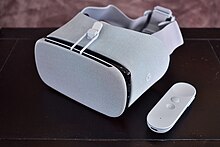
Back Google Daydream Afrikaans جوجل داي دريم Arabic Google Daydream Czech Google Daydream German Daydream (Google) Spanish گوگل دیدریم Persian Google Daydream Finnish Google Daydream French Google Daydream Italian Google Daydream Japanese
 | |
 The second-generation Google Daydream View headset with its controller | |
| Developer | |
|---|---|
| Type | Virtual reality platform |
| Release date | November 10, 2016 |
| Introductory price | Daydream View (1st gen): US$79 Daydream View (2nd gen): US$99 |
| Discontinued | October 15, 2019 |
| Operating system | Native: Android (Nougat and up) |
| Dimensions | Daydream View (1st gen): 6.6 in × 4.2 in × 3.8 in (168 mm × 107 mm × 97 mm) Daydream View (2nd gen): 6.6 in × 4.6 in × 3.9 in (168 mm × 117 mm × 99 mm) |
| Predecessor | Google Cardboard |
| Website | arvr |
Daydream is a discontinued virtual reality (VR) platform which was developed by Google, primarily for use with a headset into which a smartphone is inserted. It is available for select phones running the Android mobile operating system (versions "Nougat" 7.1 and later)[1][2] that meet the platform's software and hardware requirements. Daydream was announced at the Google I/O developer conference in May 2016,[1][2] and the first headset, the Daydream View, was released on November 10, 2016.[3] To use the platform, users place their phone into the back of a headset, run Daydream-compatible mobile apps, and view content through the viewer's lenses.
Daydream was Google's second foray into VR following Cardboard, a low-cost platform intended to encourage interest in VR. Compared to Cardboard, which was built into compatible apps and offered limited features, Daydream was built into Android itself and included enhanced features, including support for controllers. Daydream was not widely adopted by consumers or developers, and in October 2019, Google announced that the Daydream View headset had been discontinued and that they would no longer certify new devices for Daydream.[4]
- ^ a b Cite error: The named reference
Daydream announcement - The Vergewas invoked but never defined (see the help page). - ^ a b Cite error: The named reference
Daydream announcement - Ars Technicawas invoked but never defined (see the help page). - ^ Cite error: The named reference
Daydream View November 10was invoked but never defined (see the help page). - ^ Cite error: The named reference
vb-discontinuedwas invoked but never defined (see the help page).